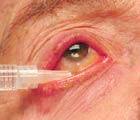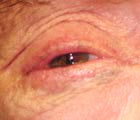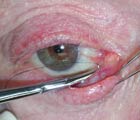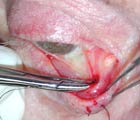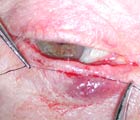Three-suture technique addresses involutional entropion in the office
Procedure provides a firm adhesion between the orbicularis and the capsulopalpebral fascia.
There have been many published procedures addressing the repair of involutional entropion. This article revisits the use of the three-suture technique first described by Quickert and Rathbun. Benger and colleagues described the initial problem of early involutional entropion as a function of lower eyelid vertical laxity. Horizontal laxity may develop from chronic tension produced by horizontal tarsal elongation. With that in mind, the majority of cases of early involutional entropion could be addressed initially by the three-suture technique described in this article. We acknowledge that the procedure does not address horizontal lid laxity and is not a permanent solution to the problem. This technique proves a valuable instrument in the surgeon’s armamentarium in treating patients with involutional entropion.
Entropion is characterized as the turning inward of the eyelid margin. This could be known to cause ocular surface irritation and discomfort for the patient, secondary to contact between cilia or keratinized skin with the ocular surface. When classifying types of entropion, it is useful to consider each one separately in order of pathophysiology and treatment. Classically, entropion has been categorized into spastic, involutional, congenital and cicatricial. The latter two are beyond the scope of this discussion, and the focus will be on spastic and involutional entropion in regard to in-office repair using rotational sutures.
Involutional, spastic
Involutional entropion is accepted as the most common cause of lower eyelid malposition. Most concur that the pathophysiology of involutional entropion is threefold: dehiscence of the lower lid retractors, thus permitting the inferior tarsal margin to move in an anterior fashion; horizontal eyelid laxity; and overriding of the pretarsal and preseptal orbicularis muscle. Originating from the inferior rectus muscle, the capsulopalpebral fascia divides around the inferior oblique muscle and combines to form Lockwood’s ligament, which continues as the capsulopalpebral fascia and the inferior tarsal muscle. With dehiscence of the lower eyelid retractors, they do not succeed in pulling the inferior tarsus in an infero-posterior direction, thus allowing the inferior tarsus to travel unopposed supero-anteriorly. While blinking, the preseptal portion of the orbicularis muscle tends to override the pretarsal portion, thus moving the upper portion of the eyelid toward the globe.
Acute spastic entropion is known to occur after an inflammatory eye disease or recent ocular surgery. It is described as a spasm leading to the preseptal portion of the orbicularis muscle overriding the pretarsal orbicularis, resulting in an inturning of the lower eyelid margin. This phenomenon is occasionally seen after cataract surgery, especially with a cul-de-sac injection of steroids, anesthesia or antibiotics. Botulinum toxin has been shown to be successful in ending the orbicularis spasm, thus ceasing the orbicularis muscle from overriding. Many cases of spastic entropion resolve when the ocular irritation has subsided. In some instances, there is an actual dehiscence of the capsulopalpebral fascia resulting in a more permanent involutional type of entropion.
Technique
Quickert and Rathbun originally described a technique for full thickness placement of sutures through the lower lid to address early involutional entropion and congenital epiblepharon. This procedure is ideal for accomplishing a firm adhesion between the orbicularis and the capsulopalpebral fascia. This addresses the main cause of acute spastic entropion developing into involutional entropion, which is dehiscence of the lower eyelid retractors. We would like to revisit this procedure in cases of spastic entropion and involutional entropion. Although it is not a permanent solution and does not address the pathophysiologic contribution of horizontal lid laxity, it is a great temporizing solution for a problem presenting significant irritation to a patient. The procedure can be performed in the office or for a chronically ill patient at the bedside.
There are two simple ways to evaluate for dehiscence of the lower lid retractors. The first involves having the patient look down. Normally the lower lid will descend several millimeters (3 mm to 4 mm), and loss of this downward movement indicates disinsertion. A second approach to detect a dehiscence of the lower lid retractors is by examining the cul-de-sac for a white band, which separates the lower lid retractors from the tarsal border. If this dehiscence is noted, the three-suture technique could prove optimal management.
The three-suture technique is displayed in the accompanying series of figures.
|
|
|
|
|
|
|
|
|
|
|
|
|
|
| (All photographs courtesy of Robert M. Schwarcz, MD.) |
For Your Information:
Robert M. Schwarcz, MD, Norman Shorr, MD, FACS, Raymond Douglas, MD, PhD, and Robert A. Goldberg, MD, FACS, can be reached at Jules Stein Eye Institute, 100 Stein Plaza, UCLA, Los Angeles, CA 90095; e-mail: schwarcz@jsei.ucla.edu.
References:
- Dresner SC, Karesh JW. Transconjunctival entropion repair. Arch Ophthalmol. 1993;111:1144-1148.
- Dortzbach RK, McGetrick JJ. Involutional entropion of the lower eyelid. Adv Ophthalmic Plast Reconstr Surg. 1983;2:257-267.
- Levine MR, Enlow MK, Terman S. Spastic entropion after cataract surgery. Ann Ophthalmol. May 1992;24(5):195-198.
- Quickert MH, Rathbun E. Suture repair of entropion. Arch Ophthalmol. 1971;85:304-305.
- Benger RS, Musch DC. A comparative study of eyelid parameters in involutional entropion. Ophthal Plast Reconstr Surg. 1989;5:281-287.


